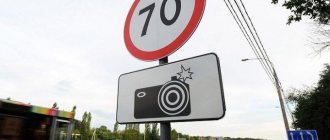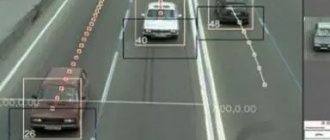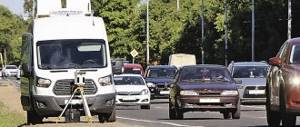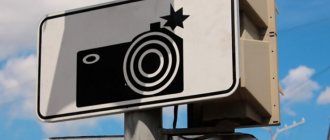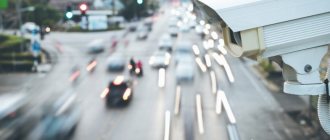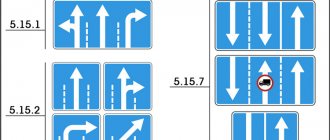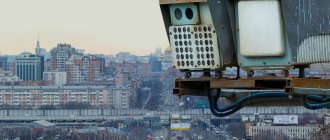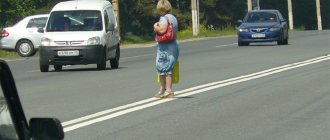There are more than 3,000 traffic cameras in the capital, which not only control the speed limit, but also record many other violations. They track cars by license plate numbers, check databases of stolen cars, and also control intersections and no-stop zones. In this situation, drivers have electronic assistants in smartphones or portable radar detectors that can detect photo-video recording systems using radar signals or via a global network. The data for the cards is taken from open sources of the data center or traffic police, which do not hide their devices.
"Camera at 60"
The most common type of traffic cameras are complexes that work to determine the speed of cars. They can be stationary, mobile or portable (for work inside patrol cars or from the hands of a traffic police inspector).
Q&A Can cameras see violations in the dark?
When meeting them about 800 meters away, the navigator issues a warning that sounds like “camera at 60” or “camera at 80.” This means that on this section of the road there is a speed limit of 60 km/h or 80 km/h, and the camera monitors compliance with the speed limit.
To clarify the location of the camera, the navigator sometimes says the phrase “on the highway” or “on the backup.” This means that only those drivers who move along these sections of roads should be wary of them.
How to challenge a fine from a camera?
Before taking action to appeal a fine, you need to carefully study the contents of the letter. Look at every detail of the photo, compare the license plate number in the photo and your car, look at the time and place. If something you saw alarmed you and led you to think about appealing the fine, then you need to formulate the reason for canceling the penalty, provide evidence, write a complaint, and submit it to the State Traffic Inspectorate within a certain period of time (no later than 10 days after receiving the letter).
Read more: How to appeal a traffic police fine?
Grounds for appealing the decision
To appeal a decision on an administrative offense issued for an offense that was recorded by an automatic photo-video recording device, compelling reasons are needed, for example:
- In the photo from the camera, the license plate number of the car is not readable, the image is unclear or blurry. Such photographs from cameras should be screened out by the operator as unidentified at the information processing stage;
- In the photo you see the license plate number of a car that is not yours. It often happens that the owner of a Chevrolet receives a photo with a photo of a KamAZ, and vice versa. There was a case in Nizhnekamsk when a car being transported on a tow truck got a fine for speeding during the trip. Although in fact the tow truck itself was speeding. Therefore, before paying, carefully study the contents of the “letter of happiness”, down to the smallest details;
- you see that the speed recorded by the camera significantly exceeds the technical speed indicators for your car. Most often this is a technical failure in the system. The most interesting case was the recording of a speed of almost 270 km/h of a Daewoo Nexia car in Izhevsk. The fine was canceled. Also, such an error is possible as a result of fast movement of the motorcycle. The problem is not speed (modern cameras can record objects moving at speeds of up to 350 km/h), but rather the rapid lane change of motorcycle vehicles. In this case, the camera sees the object, but does not have time to fix it, so the car that was nearby falls under the scope, since most cameras can only shoot the front license plates, while on a motorcycle they are at the back;
- if the fine came from a camera installed within the range of temporary road signs. You will have to prove the incompetence of the fine yourself, using personal photo and video materials;
The procedure for appealing a traffic police decision
A fine received from automatic fixation devices is disputed by the car owner only within 10 days from the date of its delivery or receipt.
A missed appeal period can only be reinstated for a valid reason (for example, illness, business trip) and upon presentation of evidence (for example, sick leave, tickets, waybill). To challenge the vehicle owner, you need to personally (or with the help of an official representative) contact the State Traffic Inspectorate office with a complaint about your disagreement with the decision. The complaint is addressed to the head of the territorial traffic police department or higher management. In a simple written form, you need to reflect the reasons and evidence of innocence, as well as a request to cancel the fine. Fines with which the owner of the vehicle does not agree, and the photographic recording does not correspond to reality or was carried out with violations, cannot be ignored; actions must be taken to cancel them. Otherwise, over time, the traffic police will send the unpaid fine to the bailiffs, who will begin to seize accounts, property, and impose other restrictions on the debtor.
"Camera on the strip"
Very often, the stationary complexes “Strelka”, “Cordon”, “Arena” and others are trained to detect not only the speed of movement of vehicles, but also other violations of traffic rules (traffic rules).
They are mounted on high masts, over 10 meters above the ground, and have an extremely wide viewing angle. These complexes scan up to four lanes of traffic and are armed not only with radar and a Doppler signal return meter, but also video cameras with infrared illumination, as well as software that determines the trajectory of vehicles. Such cameras, if equipped with the appropriate software, are capable of monitoring the flow of traffic and see cars that have entered public transport lanes in violation of the rules. For such an act a fine of 3,000 rubles is imposed. In addition, the program calculates the trajectory of cars, and if it passes through several lanes and crosses solid markings, the driver will be fined 500 rubles.
Question answer
Why is it no longer possible to hide from cameras behind a reckless driver in front?
“Cordons” can detect cars moving on the side of the road or in the oncoming lane. Therefore, in order to warn drivers about such cameras, simple and succinct phrases are introduced into navigation programs: “Camera on the lane.”
The main misconceptions of drivers when driving along a passing road
There is a misconception that crossing solid markings is a violation only in the case of driving into oncoming traffic or the side of the road. Drivers mistakenly believe that they can maneuver in lanes in the same direction, despite the 1.1 markings. The traffic rules clearly regulate the prohibition of crossing line 1.1 in any direction, because it is placed before areas with increased danger, such as:
- proximity to the intersection;
- exit to the bridge;
- approaching the tunnel.
Violation of the markings when changing lanes entails a fine of 500 rubles. Also, in order to avoid committing crimes, you need to be well aware of what the intersection monitoring camera records.
"Control complex"
Sometimes the camera is installed only in the lane it is supposed to monitor. But sometimes on multi-lane highways “Avtouragan” systems are used, consisting of several cameras at once, tuned to a specific sector of the road. They calculate the speed of cars based on the time of movement in the field of view of the device and do not use radar. The competence of these devices includes recording violations at intersections, driving on tram tracks and bicycle paths, crossing a stop line or railway crossing at a prohibiting traffic light, as well as driving under a prohibiting sign.
When a traffic camera records several types of offenses, the navigator warns the driver in this way: “Attention, camera. Control complex." Having heard this phrase, it is better not to violate the marking requirements, otherwise you may receive fines ranging from 500 to 3,000 rubles.
In general, the functionality of navigation devices will only expand as new road photo and video recording systems come into force. Next in line is the phrase “crossing camera,” which informs about the need to let pedestrians pass at the zebra crossing, as well as “MTPL camera,” which warns about the operation of a device that remotely determines the presence of insurance.
Penalty for crossing a passing lane when changing lanes
Road markings serve to delimit traffic flows and are used both independently and in conjunction with road signs. The name and graphic display of the types and purposes of markings are prescribed in Appendix 1 to the Russian Traffic Regulations.
Violation of marking requirements is an administrative offense and is punishable in accordance with Art. 12.16 Code of Administrative Offenses of the Russian Federation.
A car driver who changes lanes in the same direction across a solid line, if such a violation is recorded on camera, will receive a penalty of 500 rubles.
A traffic police inspector has the right to issue a fine for crossing a solid line in the same direction. Both options provide preferential payment. In addition, there is a fine for turning across a continuous road.
New cameras 2021
Let's start with the latest and simply new video recording systems that were installed on Russian roads not so long ago. Below we will show you how to find them on the map.
Hummingbird
This is one of the newest video recording systems, which is being actively installed in 2021 on Russian roads. On the map you can find them so far mainly in Moscow and Kazan, but they are also spreading in other cities.
The main advantage of the complex is its size, thanks to which they can be installed easily and in different places. Drivers often don’t notice them and therefore don’t slow down.
You will also be interested in:
- Traffic police cameras in Largus - how legal are they and what violations are they caught for?
- Can traffic police patrol in a civilian or private car, stop and fine?
- We drove under the camera at a yellow traffic light: will there be a fine and how to appeal?
Avtodoriya
This is a hardware and software complex that measures the speed of cars not using radars, but by mathematical calculations of the time it takes a recorded car to cover the distance between several recorders.
The system provides zonal speed control on road sections ranging from 250 meters to 10 km, and therefore it does not matter to the driver what distance he is from the recorder.
That is why there is no point in slowing down when passing Avtodoriya - it calculates the average speed in the section between two cameras.
Avtodoriya, in addition to speed, controls:
- intersection of dividing strips,
- detects violations of parking and stopping rules,
- records driving on the side of the road or in the public transport lane and other violations.
In addition, these traffic police cameras transmit online up-to-date information about the current traffic congestion. In 2021, you can find them on maps of Moscow, St. Petersburg, Kazan, Volgograd, Krasnodar and a number of others - mainly on highways near large cities.
You can see how Avtodoria records violations in the manufacturer’s official video.
Video recording of traffic violations. How to find out about the camera?
Previously, drivers did not know about the presence of cameras and drove without even suspecting that they would soon receive a “chain letter”. From July 1, 2013, roads must have a warning sign or special markings.
First, let's look at the sign. It belongs to the category “Signs of additional information”. The sign “Photo and video recording” of traffic violations has its own number in the traffic rules – 8.23
Applicable with signs 1.1, 1.2, 1.8, 1.22, 1.35, 3.1 - 3.7, 3.18.1, 3.18.2, 3.19, 3.20, 3.22, 3.24, 3.27 - 3.30, 5.1 - 5.4, 5.14, 5.21, 5.23.1 , 5.23 .2, 5.24.1, 5.24.2, 5.25 - 5.27, 5.31, 5.35 and 5.36, as well as with traffic lights. Indicates that in the coverage area of a road sign or on a given section of the road, administrative offenses can be recorded using automatic special technical means that have the functions of photography, filming and video recording, or by means of photography, filming and video recording.
Traffic rules sign 8.23
Its dimensions are determined by GOST R 51256-2018. National standard of the Russian Federation. Technical means of organizing traffic. Road markings. Classification. Technical requirements".
It is worth noting that using only a sign without road markings is not allowed, so I suggest going directly to it.
The markings also have their own standards established by GOST R 52289–2004 “Technical means of organizing traffic. Rules for the use of road signs, markings, traffic lights, road barriers and guide devices" and GOST R 52290–2004 "Technical means of organizing road traffic. Road signs. General technical requirements". In the traffic rules it is also assigned its own serial number - 1.24.4.
Various variations of the camera image inside the rectangle are allowed, but the dimensions of the triangle themselves are specified in GOST.
It is used to duplicate the additional information sign of plate 8.23 “Photo and video recording” and is applied in the same cross section of the road with sign 8.23. On multi-lane roads, markings 1.24.4 are applied on each lane, with the exception of cases when the fixation is carried out along a dedicated lane. It can be used independently, while marking 1.24.4 is applied outside the populated area at least 300 m, and in the populated area at least 100 m before the beginning of the road section on which fixation can be carried out, and then every 500 m throughout. If there are junctions or intersections, marking 1.24.4 is repeated after each intersection.
Traffic regulations road markings 1.24.4
Please note that the image on the road is slightly elongated. This is done so that while driving the image appears to the driver in normal proportions.
Traffic police inspectors are confident that if citizen motorists see a warning that a few meters away there is video or photographic recording of traffic violations, then he will definitely slow down. In fact, the speed will be reduced, but only within the camera's view, then the speed will be exceeded again.
At what distance does the Cordon camera begin to record?
Another new widespread camera for photo-video recording of traffic violations on Russian roads. There are many different modifications of this complex. The most common is Kordon-M4. This complex, like the arrow, uses combined components that measure the speed of vehicles: a radar operating at a frequency of 24.15 GHz and a photo and video camera. According to the technical characteristics indicated on the official website, the length of the control zone of the photoradar unit is only 10-50 meters. As you can see, this complex is noticeably inferior to the technical capabilities of the Strelka complex.
Types of cameras for recording violations
All devices used to identify violators on the roads are divided into 2 types:
- Automatic cameras.
- Devices used by police officers.
Automatic cameras
The advantage of automatic recorders is the ability to record a significant number of violations on the roads, due to their versatility. As for the legislative definition of the types of violations that should be recorded by cameras, today there is no such list.
All cameras operating in automatic mode can be divided into 3 types:
- Stationary;
- Portable;
- Mobile.
Stationary cameras
Stationary devices operate in a strictly defined location. Once configured, the cameras operate automatically, record certain violations and send them to the police department, from where “chain letters” are subsequently sent to violators. This type of camera is capable of detecting the following traffic violations:
- Over speed;
- Driving at a prohibiting traffic light;
- Driving in oncoming traffic;
- Stopping the car behind the stop line;
- Driving a vehicle under a prohibiting sign;
- Driving in a lane designated for public transport;
- Intersection of a solid marking line;
- Driving on the sidewalk;
- Violation while overtaking vehicles;
- Violation of the rules for the movement of freight vehicles on highways;
- Not giving priority to pedestrians at a pedestrian crossing;
- Turning or turning around from the second lane for traffic;
- Driving outside a populated area without turning on low beam headlights.
Fixed cameras come in several brands:
- The Strelka device can determine the specific type of vehicle that is stored in its memory. Recognizes several dozen cars at a distance of up to 500 meters. When a vehicle approaches at a distance of 50 meters, the camera records its license plate number and the speed at which it is moving.
- The Avtodoriya device is capable of recording traffic violations at a distance of 3 kilometers to 100 meters. The device does not have a built-in radar, so the speed of the car is determined by photographic recording at the beginning of the segment on which the device operates and at its end.
- The AvtoUragan-VSM complex can detect about 15 traffic violations. Despite the lack of radar, thanks to the built-in camera, the device records the speed of the vehicle, as well as the time of its movement.
- "Vocord" - determines the speed of movement of the vehicle thanks to a lens that takes several frames at a high frequency.
- The Arena device can be used as a stationary or mobile device. Capable of detecting violations at any time of the day. Records vehicle speed in the range from 20 to 250 km/h.
Portable cameras
Portable devices – can be used in different locations. Each time after changing the location of such a camera, it must be reconfigured. With the help of such devices, you can only detect violation of the speed limit on the road.
Mobile cameras
Mobile devices are usually used to equip vehicles of traffic police officers.
Such devices are intended for:
- Confirmation of speed limit violations on the road;
- Recording violations of parking rules;
- Recording violations of the payment procedure during cargo transportation.
With their help, a violation is determined even when vehicles are moving.
Dear reader! Didn't receive an answer to your question? Our expert lawyers work for you. It's absolutely free!
- Moscow ext 152
- St. Petersburg ext 152
- All regions ext 132 (Toll free)
In addition to the classification discussed above, violation recording devices can also be grouped according to the principle of their operation:
- Radar is a camera with a sensor, which is used to record the speed of a moving car, and only then video recording. These devices have significant errors.
- Laser devices. These are the most modern cameras with a minimal percentage of inaccuracies. As a rule, they are installed along the road so that the devices can record traffic in all lanes.
- Video recording devices. These are devices whose operating principle is to produce a certain number of photographs of a vehicle over a certain period of time. After this, the speed limit of the vehicle is calculated.
Restraint devices for traffic police officers
These special equipment are used to help traffic police officers establish and confirm an offense by the driver of the vehicle. When using them, the inspector will be able to confirm the validity of his claims against the driver and fine him at the place of stop.
The use of such devices is possible in several ways:
- Recording an offense using a device and stopping the driver by an inspector. Having presented the driver with evidence of his traffic violation, the traffic police officer issues a fine;
- The violation is recorded by an inspector using a device and the data is transmitted to the nearest traffic police post. There, police officers stop the vehicle, present the driver with evidence of his violation and draw up a report;
- The fixation device is located at a distance from the traffic police post. Using the ability to recognize license plates, this device analyzes information about cars using various databases and transmits it to the traffic police post. There, employees stop the desired vehicle and detain it.



